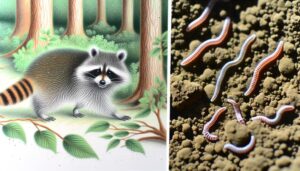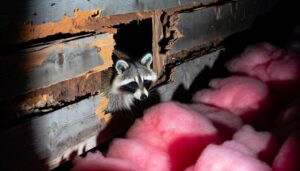How Do Raccoons Live in Florida’s Suitable Habitat?
Raccoons are indeed common residents of Florida, inhabiting diverse environments from mangrove swamps to pine flatwoods and urban areas. Adapted to these varied habitats, raccoons employ dense vegetation, tree cavities, and man-made structures for shelter.
They exhibit nocturnal behavior, foraging for an omnivorous diet that includes fruits, insects, and small mammals. Their dexterous front paws aid in scavenging, particularly in urban settings where they frequently encounter human waste.
Challenges include habitat fragmentation and increased disease risk due to urban expansion. Intriguing behavioral adaptations and interactions with humans highlight their resilience and adaptive skills in Florida's ecosystem.
Explore further to uncover more about these fascinating creatures.
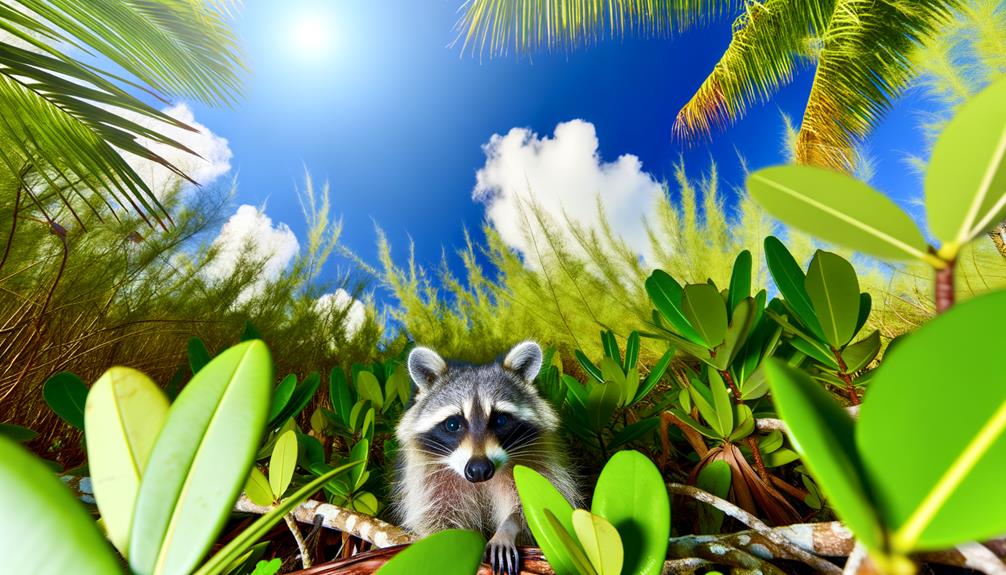
Key Takeaways
- Raccoons inhabit various regions in Florida, including mangrove swamps, pine flatwoods, and urban areas.
- They are nocturnal and adapt well to different environments, including human-populated areas.
- Raccoons in Florida have an omnivorous diet, consuming fruits, nuts, insects, and small mammals.
- They face challenges like habitat fragmentation, traffic, and competition for food resources.
- Raccoons often interact with humans, scavenging in garbage bins and potentially spreading diseases.
Raccoon Habitats in Florida
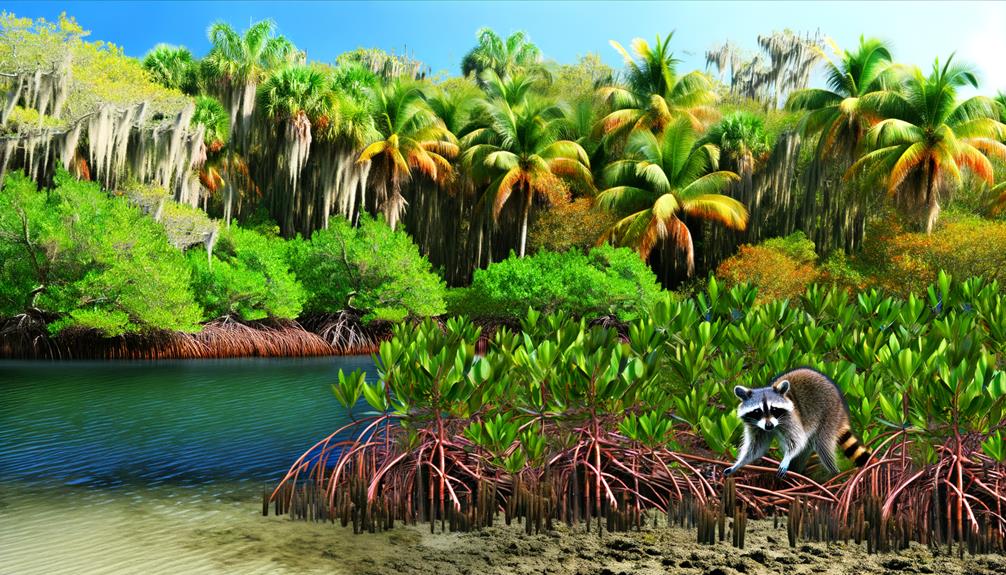
Raccoons in Florida mainly inhabit diverse ecosystems, including mangrove swamps, pine flatwoods, and urban areas, where they exhibit remarkable adaptability to varying environmental conditions. These mammals are particularly adept at exploiting a range of habitats due to their nocturnal nature and omnivorous diet.
In mangrove swamps, they utilize the dense vegetation for shelter and nesting. Pine flatwoods offer them ample ground cover and tree cavities for dens. Urban environments present unique challenges and opportunities, where raccoons have adapted to human presence by scavenging and seeking shelter in attics, sewers, and other man-made structures.
Their behavioral plasticity allows them to thrive across these varied landscapes, demonstrating an impressive capacity for ecological flexibility and survival in both natural and anthropogenic settings.
Diet and Feeding Habits
Their ability to thrive in diverse habitats is closely linked to their versatile diet, which includes a wide variety of plant and animal matter, enabling them to exploit numerous food sources across different environments.
Raccoons in Florida consume fruits, nuts, seeds, insects, small mammals, birds, and amphibians. They are also known to scavenge human food waste, demonstrating an opportunistic feeding strategy.
Detailed observations reveal that raccoons exhibit dexterous manipulation skills, allowing them to access food sources that are otherwise challenging to obtain. Additionally, they display seasonal dietary adaptations; for instance, during the winter months, they rely more heavily on available animal matter due to the scarcity of plant-based food sources.
This dietary flexibility is integral to their survival in Florida's varied ecosystems.
Raccoon Behavior Patterns
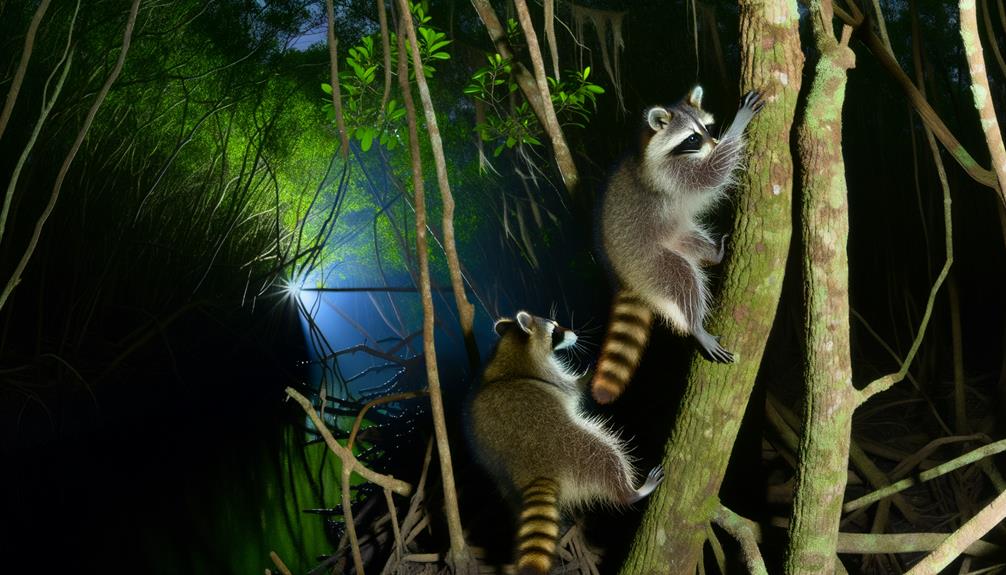
Exhibiting complex social structures and adaptive behaviors, raccoons in Florida demonstrate a range of activity patterns that reflect their highly adaptable nature. Typically nocturnal, they exhibit peak activity during twilight hours. Raccoons are known for their dexterous front paws, which they use to forage for food and explore their environment. They often inhabit areas near water sources, making use of Florida's diverse habitats, from urban to marshlands. Socially, female raccoons may form small, transient groups, whereas males are generally solitary.
| Activity | Time of Day |
|---|---|
| Foraging | Night |
| Resting | Day |
| Social Interactions | Night |
| Grooming | Night and Day |
| Nesting | Day |
These behaviors underscore their ability to thrive in varied environments.
Challenges Raccoons Face
Roaming an increasingly urbanized landscape, raccoons in Florida encounter numerous challenges that threaten their survival and well-being. Habitat fragmentation due to urban expansion limits their access to natural foraging grounds, forcing them into closer proximity with human development. This shift exacerbates their exposure to vehicular traffic, leading to higher mortality rates.
In addition, raccoons face increased competition for dwindling food resources, which can result in malnutrition and weakened immune systems. The presence of domestic pets also introduces new predators and potential vectors for disease transmission.
Moreover, environmental pollutants and pesticide use can adversely affect raccoon health, disrupting their natural behaviors and reproductive success. Collectively, these factors culminate in a precarious existence for Florida's raccoon populations.
Interaction With Humans
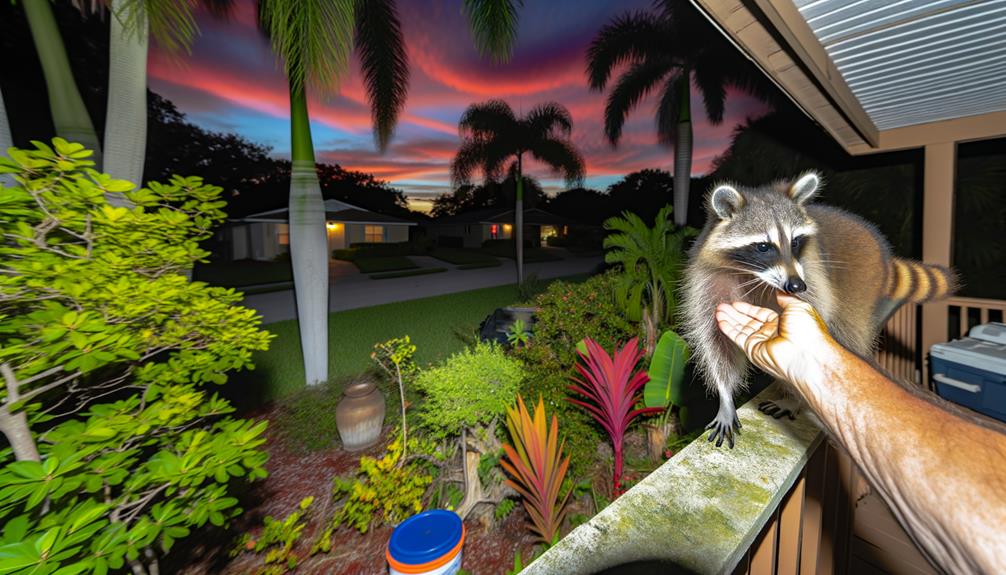
As urban encroachment continues, raccoons in Florida increasingly interact with humans, often leading to conflicts that highlight the adaptability and opportunistic behavior of these animals. These nocturnal creatures are adept at scavenging, frequently rifling through garbage bins and pet food left outdoors.
Such behaviors not only create a nuisance but also elevate the risk of disease transmission, including rabies and leptospirosis. Observational studies indicate that raccoons exhibit remarkable problem-solving skills, enabling them to exploit urban resources effectively. Additionally, their dexterous front paws allow them to open containers and access food sources that other wildlife cannot.
While these interactions underscore their resilience, they also necessitate careful management to mitigate potential risks to human health and property.
Raccoon Conservation Efforts
Recognizing the challenges posed by increasing human-raccoon interactions, various conservation efforts in Florida are focused on promoting coexistence and safeguarding both public health and wildlife well-being. These initiatives involve scientific strategies and community engagement to address the complex dynamics of raccoon behavior and habitat requirements.
- Public Education Programs: Disseminating information on raccoon behavior and safe coexistence practices.
- Habitat Preservation: Protecting natural habitats to guarantee raccoons have sufficient food and shelter.
- Rabies Vaccination Campaigns: Implementing bait vaccination programs to control rabies in raccoon populations.
- Wildlife Rehabilitation: Providing care and rehabilitation for injured or orphaned raccoons.
- Research and Monitoring: Conducting studies to monitor raccoon populations and their health status.
These efforts aim to balance ecological integrity with public safety, fostering a sustainable relationship between humans and raccoons.
Conclusion
The raccoon, a tenacious survivor, navigates the diverse habitats of Florida with remarkable adaptability, akin to a skilled chess player maneuvering a complex board. Their omnivorous diet, nocturnal habits, and unique problem-solving abilities enable them to thrive despite numerous challenges, such as habitat loss and human encroachment.
Conservation efforts, much like a lighthouse guiding ships through tumultuous seas, continue to play an essential role in ensuring the persistence of this resilient species in Florida's dynamic ecosystems.





